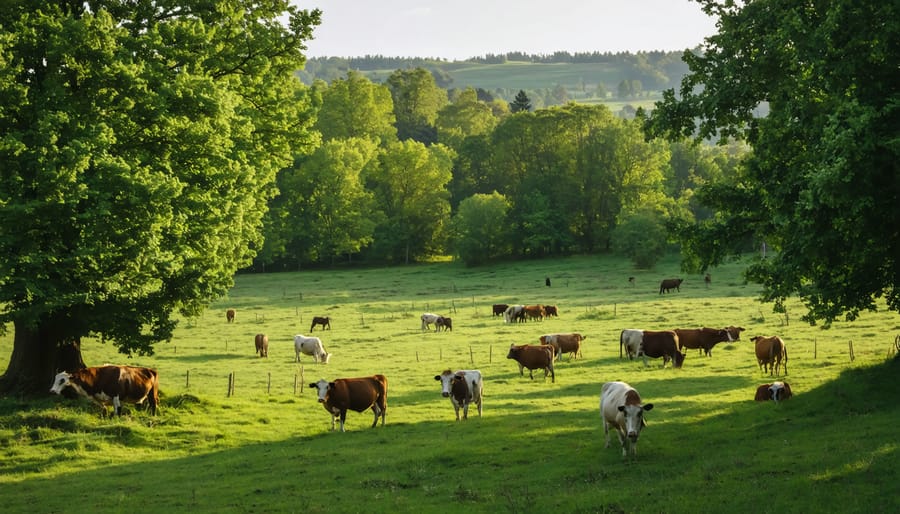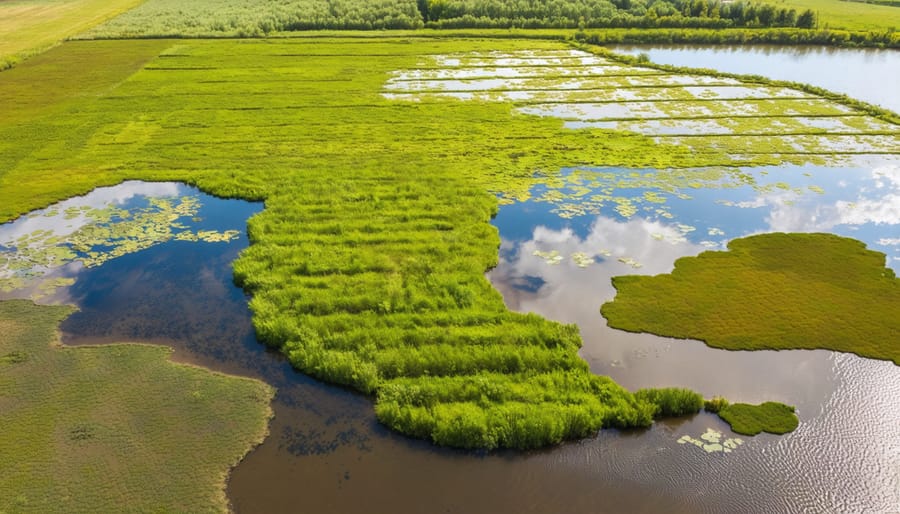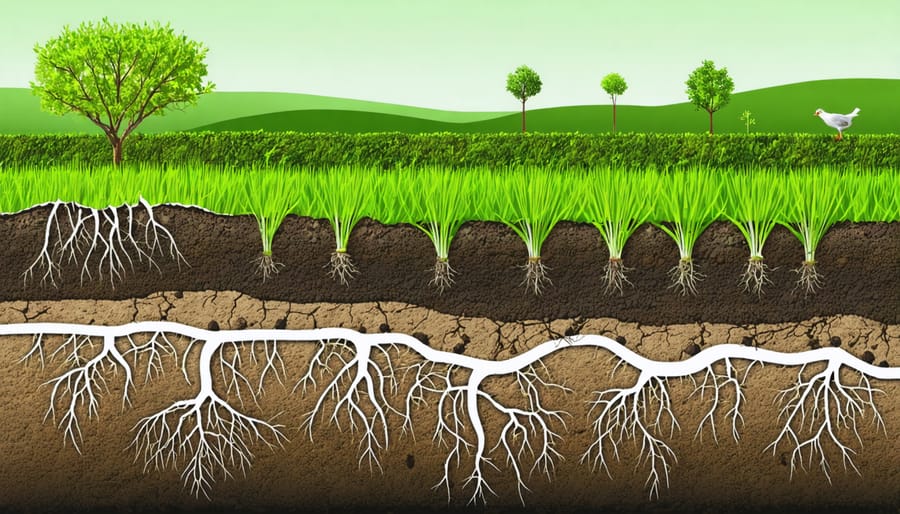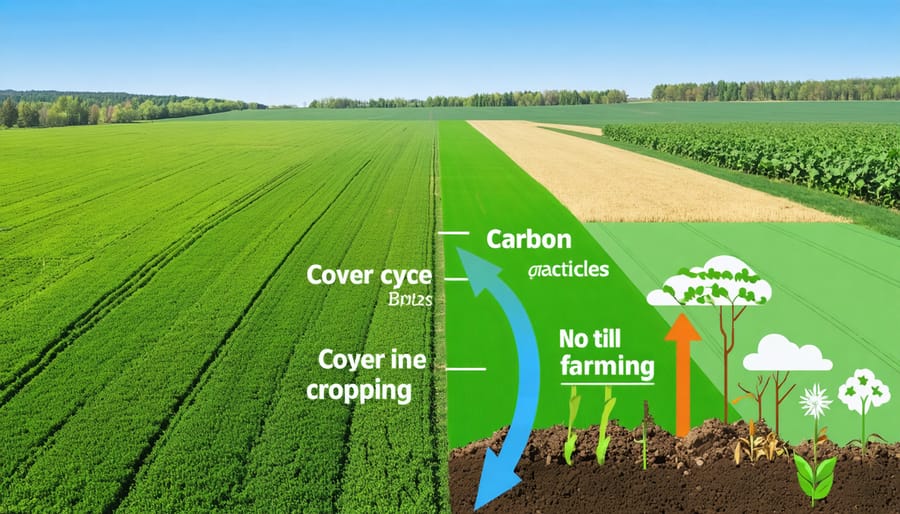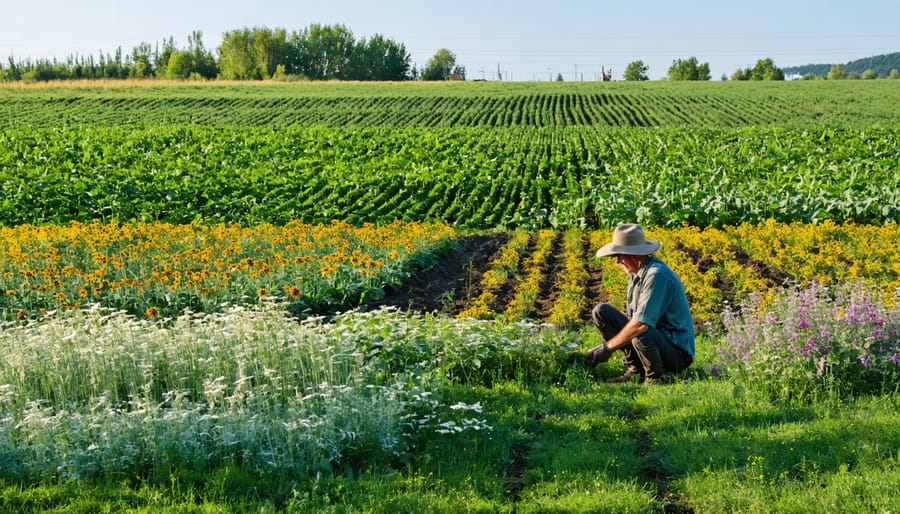Transform traditional grazing operations into thriving ecosystems by integrating trees, livestock, and forage crops through silvopasture. This innovative agricultural practice has demonstrated proven silvopasture success across Alberta’s diverse landscapes, delivering multiple benefits for farmers and the environment. By strategically planting trees in pastures, producers create natural shelter belts that protect livestock, enhance soil fertility, and generate additional income streams through timber and non-timber forest products. The system’s integrated approach captures up to five times more carbon than conventional grazing while improving animal welfare and boosting farm resilience against climate extremes. For Alberta farmers seeking sustainable solutions, silvopasture offers a practical path to increased profitability while contributing to Canada’s climate action goals. Recent studies show that properties implementing silvopasture systems have experienced up to 200% increases in per-hectare productivity compared to traditional single-use grazing lands.
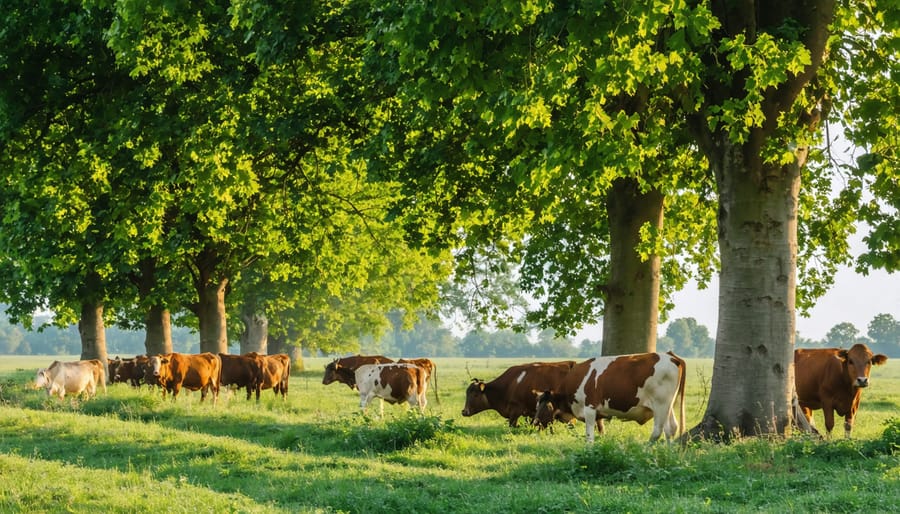
Economic Advantages of Silvopasture Systems
Multiple Income Streams
One of the most compelling advantages of silvopasture is its ability to generate multiple revenue streams from the same piece of land. By integrating trees, livestock, and forage production, Alberta farmers can diversify their income sources and build more resilient farm operations.
Timber production offers long-term returns through selective harvesting of high-value species like spruce and poplar. While trees mature, farmers continue earning from livestock operations, whether it’s cattle, sheep, or other grazing animals. The improved pasture conditions often lead to better weight gain in livestock and higher-quality meat production.
The forage component provides additional revenue through hay production or reduced feed costs. Many Alberta farmers report significant savings on winter feed expenses due to extended grazing seasons and enhanced pasture quality under silvopasture systems.
Emerging opportunities in carbon credit investment models are adding another potential income stream. As carbon markets develop, farmers implementing silvopasture practices may qualify for carbon offset credits, creating a new revenue source while contributing to climate change mitigation.
Local success stories, like the Thompson family farm near Red Deer, demonstrate how combining these income streams can increase net farm income by 25-40% compared to conventional single-use systems. Their integrated approach has proven particularly valuable during market fluctuations, providing financial stability through diversified revenue sources.
Risk Management Benefits
In today’s volatile agricultural markets, silvopasture offers farmers a robust risk management strategy through income diversification. By combining timber, livestock, and sometimes additional products like nuts or berries, farmers create multiple revenue streams that help buffer against market fluctuations and weather-related challenges.
When traditional livestock markets experience downturns, the timber component continues to appreciate in value, providing long-term financial security. For example, several Alberta ranchers report that during the 2014-2015 cattle market downturn, their established silvopasture systems helped maintain stable farm income through selective timber harvesting.
The multi-layered approach also provides protection against extreme weather events. During drought periods, trees offer shade and maintain soil moisture, reducing heat stress on livestock and preserving forage quality. This natural insurance typically results in reduced feed costs and veterinary expenses compared to conventional pasture systems.
The diversity of products from silvopasture systems also opens up premium market opportunities. Many Alberta farmers have successfully marketed their silvopasture-raised beef as an environmentally sustainable product, commanding higher prices in specialty markets. Additionally, carbon credit programs are increasingly recognizing silvopasture systems, offering potential additional revenue streams for farmers implementing these practices.
By spreading risk across different agricultural sectors, silvopasture helps create more resilient farm operations that can better weather economic uncertainties while building long-term equity through timber assets.
Carbon Sequestration Potential
Tree-Soil Carbon Storage
Trees and pasture systems work together in silvopasture to create a powerful carbon sink through multiple pathways. The trees themselves store carbon in their trunks, branches, and roots, while simultaneously enriching the soil beneath them. Here in Alberta, we’ve seen remarkable results with species like hybrid poplars and white spruce, which can sequester between 3-7 tonnes of carbon per hectare annually.
The soil plays an equally crucial role in this process. Through various soil carbon storage techniques, silvopasture systems can increase organic matter content significantly. Tree roots extend deep into the soil, depositing carbon through root turnover and exudates. Meanwhile, fallen leaves and branches contribute to the surface organic matter, which gradually becomes incorporated into the soil.
Local research at the University of Alberta has shown that silvopasture systems can store 30% more carbon in soil compared to conventional pastures. This increase comes from the combination of tree litter, enhanced microbial activity, and improved soil structure. The presence of livestock adds another dimension, as their grazing patterns and manure contribute to nutrient cycling and carbon incorporation.
What’s particularly exciting for Alberta farmers is that this carbon storage continues year-round, even during our cold winters. The deep root systems maintain soil stability and continue storing carbon when surface activity slows. Plus, the trees provide additional benefits like wind protection and snow capture, which help maintain soil moisture and further support carbon sequestration processes.
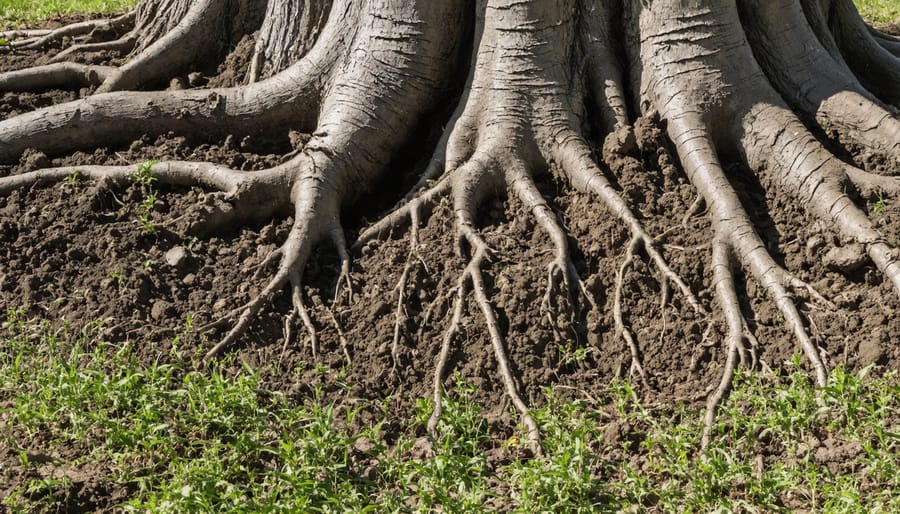
Measurement and Verification
Alberta farmers implementing silvopasture systems can now track their carbon sequestration efforts through several established methods and programs. The Alberta Carbon Offset System provides standardized protocols for measuring carbon storage in agricultural landscapes, including silvopasture projects.
Field measurements typically involve soil sampling at different depths, conducted every 3-5 years to track changes in soil organic carbon. Tree biomass calculations are performed using diameter measurements at breast height (DBH) and tree height data, following Forestry Canada’s established guidelines. These measurements help farmers quantify both above-ground and below-ground carbon storage.
Local agricultural extension offices offer support for implementing monitoring programs, including access to soil testing services and expertise in carbon measurement protocols. Many farmers are partnering with organizations like ALUS Canada and the Agricultural Research and Extension Council of Alberta (ARECA) to establish baseline measurements and track progress over time.
Digital tools are increasingly available to support verification efforts. Satellite imagery and drone technology help monitor canopy coverage and tree growth, while specialized software applications assist in calculating carbon sequestration rates. The University of Alberta’s Agroforestry and Woodlot Extension Society (AWES) provides training on using these tools effectively.
Farmers participating in carbon offset programs must maintain detailed records of their management practices, including grazing rotations, tree planting dates, and soil amendments. This documentation, combined with regular measurements, creates a comprehensive picture of carbon sequestration achievements and helps validate carbon credits for those participating in Alberta’s offset market.
Remember that consistent, long-term monitoring is key to demonstrating the carbon benefits of silvopasture systems and securing potential carbon credit revenues.
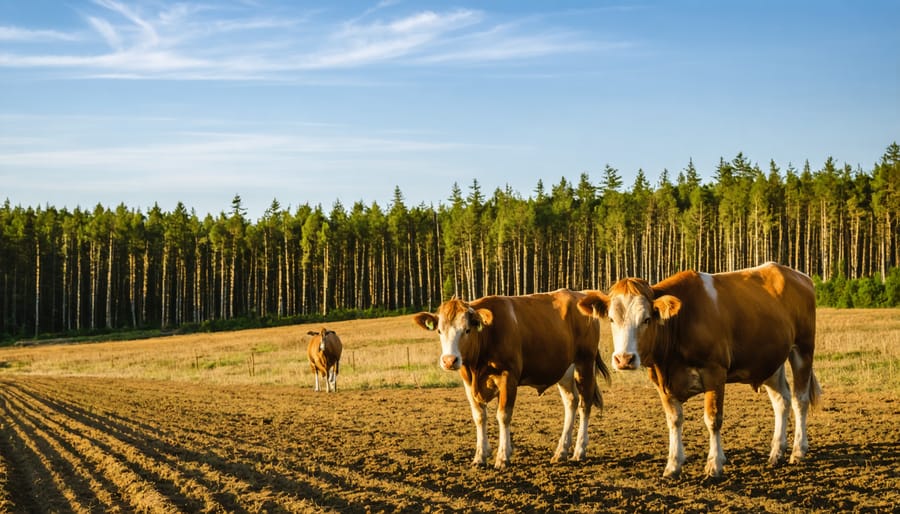
Alberta Success Stories
Northern Alberta Ranch Profile
The Hartley Family Ranch, located 50 kilometers north of Peace River, Alberta, has become a regional success story in silvopasture implementation. In 2015, Tom and Sarah Hartley transformed their traditional cattle operation into a thriving silvopasture system by integrating managed grazing with existing aspen and white spruce stands across 640 hectares.
“We saw an opportunity to make our land work harder for us while improving soil health and animal welfare,” explains Tom Hartley. The ranch now runs 200 head of cattle through carefully planned rotational grazing patterns among the trees, which provide natural shelter and supplementary browse material.
The Hartleys have documented a 30% reduction in winter feed costs since implementation, as the tree coverage provides wind protection and extends the grazing season by up to three weeks. Soil testing has shown increased organic matter content, rising from 3.2% to 4.8% over five years.
The ranch has also diversified its income streams by selectively harvesting mature trees and maintaining bee colonies that benefit from the diverse flowering understory. Local wildlife populations have noticeably increased, with regular sightings of deer, grouse, and songbirds throughout the property.
“The biggest surprise was how quickly we saw positive changes,” Sarah notes. “Within two years, our cattle were healthier, our soil was improving, and our operating costs were down. It’s been a win-win for our family and the environment.”
Measured Results and Outcomes
Recent studies conducted across Alberta’s agricultural regions have demonstrated impressive results from silvopasture implementation. Data collected from a five-year study in central Alberta showed that farms incorporating silvopasture systems sequestered an average of 3.4 tonnes of carbon per hectare annually, compared to 0.8 tonnes in conventional grazing systems.
Financial outcomes have been equally encouraging. A 2022 survey of 15 Alberta farms practicing silvopasture reported a 25-35% increase in overall farm revenue within three years of implementation. This improvement stems from diversified income streams, including timber production and increased livestock gains.
Livestock performance metrics show that cattle in silvopasture systems gained an additional 0.2-0.3 kg per day during summer months compared to those in open pastures, primarily due to reduced heat stress. Winter feed costs decreased by approximately 20% due to windbreak effects and extended grazing seasons.
Soil health measurements revealed a 40% increase in organic matter content and improved water retention capacity, with silvopasture plots holding up to 25% more moisture than conventional pastures. Biodiversity assessments documented a 45% increase in bird species and a 30% rise in beneficial insect populations.
These results align with broader Canadian agricultural data, suggesting that silvopasture systems can provide both environmental benefits and economic advantages while supporting long-term agricultural sustainability in Alberta’s diverse climate conditions.
Implementation Steps for Your Farm
Planning and Design
Before implementing a silvopasture system, careful planning and design are essential for long-term success. Start by assessing your land’s characteristics, including soil type, topography, and existing vegetation. Consider working with a local agricultural extension officer or professional forester to develop a site-specific plan that aligns with your goals.
When selecting tree species, focus on native varieties well-suited to Alberta’s climate. Popular choices include white spruce, trembling aspen, and lodgepole pine, which can provide both timber value and livestock shelter. Space trees appropriately – typically 200-400 trees per hectare – to allow sufficient light for forage growth underneath.
Incorporate sustainable grazing methods by dividing your pasture into paddocks for rotational grazing. This approach helps prevent overgrazing and promotes healthy root systems in both trees and forages.
Consider your livestock type when designing fencing and protection systems. Young trees will need guards or electric fencing until they’re established enough to withstand animal contact. Plan water access points strategically throughout the system to ensure even grazing distribution.
Remember to factor in equipment access for maintaining pastures and harvesting timber. Creating wider alleys between tree rows (8-12 metres) allows for efficient mowing and baling operations while maintaining the benefits of the integrated system.
Available Resources and Support
Alberta farmers interested in implementing silvopasture systems can access numerous support channels and resources. The Agricultural Climate Solutions (ACS) program offers funding of up to $75,000 for on-farm climate-smart projects, including silvopasture establishment. The Canadian Agricultural Partnership (CAP) provides additional grants specifically for environmental stewardship initiatives.
Local expertise is available through Alberta’s Agroforestry and Woodlot Extension Society (AWES), which offers free consultations and workshops throughout the year. The organization connects farmers with experienced silvopasture practitioners and provides detailed guides on species selection and management strategies suited to Alberta’s climate.
The Agriculture and Agri-Food Canada’s Environmental Farm Plan (EFP) program supports farmers with technical assistance and potential cost-sharing opportunities. Participants can access specialized advisors who help develop customized silvopasture implementation plans.
Regional agricultural fieldmen and conservation districts offer hands-on support, including soil testing services and equipment rental programs. The University of Alberta’s Faculty of Agricultural, Life & Environmental Sciences maintains demonstration sites and conducts regular field days where farmers can observe successful silvopasture systems firsthand.
For ongoing support, the Alberta Woodlot Extension Program hosts a quarterly newsletter and maintains an online resource library with practical guides, case studies, and research findings specific to the province’s growing conditions and agricultural practices.
Silvopasture represents a powerful opportunity for Canadian farmers to enhance their operations while contributing to environmental sustainability. The combined benefits of increased biodiversity, improved soil health, enhanced animal welfare, and diversified income streams make this system particularly valuable for Alberta’s agricultural landscape. By integrating trees, forage, and livestock, farmers can create resilient operations that weather both economic and environmental challenges. The time to act is now – start small, learn from fellow farmers who have successfully implemented silvopasture, and connect with local agricultural extension services for guidance. Together, we can build a more sustainable and profitable future for Canadian agriculture while playing our part in climate change mitigation. Consider taking the first step by assessing your land’s potential for silvopasture implementation and developing a practical transition plan that works for your operation.

